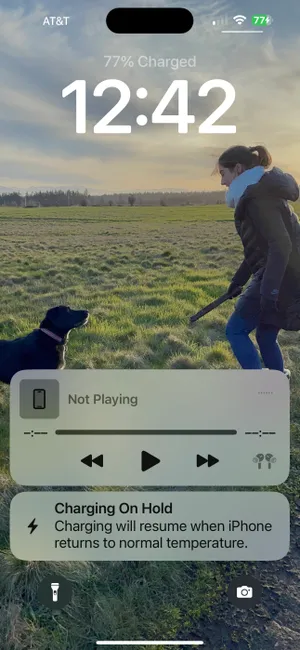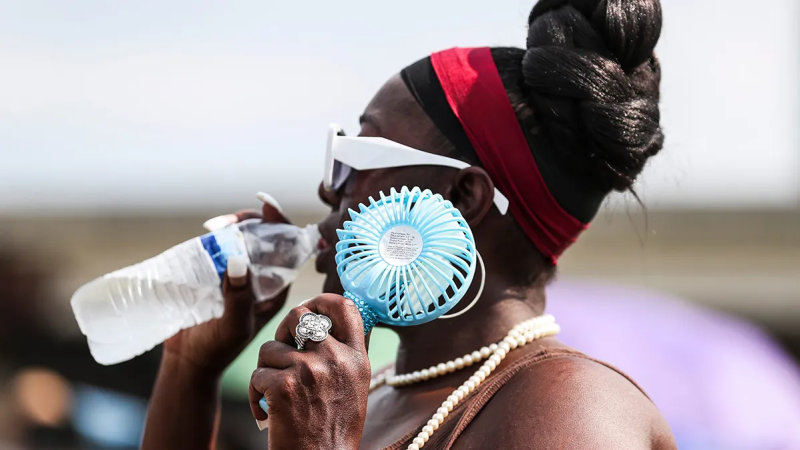iPhone got too hot? Here’s how to keep your device from overheating in scorching temps
- Smartphones, tablets, and other gadgets can overheat in extreme heat.
- High temperatures can shorten battery life, damage parts, and make your device run slow.
- One tip is to keep your devices out of direct sunlight.
Letting your smartphone, tablet, laptop and other go-to gadgets get too hot can shorten battery life, damage parts and make your device run sloth-like slow. In extreme cases, heat buildup can even cause a smartphone battery to spark a fire.
They don’t make sunscreen for smartphones, but if they did, now would be the time to use it.
Summer arrived in the United States with a record-breaking blast of heat and humidity. As humans, it’s uncomfortable − and, at times, downright dangerous − to be exposed to such extreme conditions. Unfortunately, the same is true for your high-tech devices.
Here’s everything you need to know to keep your pricey smartphone and other gadgets safe from the sweltering heat.

How hot is too hot for your smartphone?
Most modern smartphones have temperature safety features that put them in standby mode or automatically shut them off when temperatures get too high. But that’s no guarantee the heat won’t cause lasting damage if temperatures creep higher.
Apple, Samsung, Google and other manufacturers agree that you shouldn’t use smartphones in extremely high temperatures. Most say that 95 degrees Fahrenheit (35 degrees Celsius) is the upper limit for what your handheld can handle. If you’re storing your phone (and turning it off), the limits are slightly higher, about 113 degrees Fahrenheit (45 Celsius), but that’s pushing it.
Anything over those recommended limits puts the electronics − and possibly even you − at risk.
Keep in mind that even if your weather app says it’s 95 degrees, that’s just the ambient temperature, and localized temps can be much, much higher. For example, if you leave your phone on the dashboard of your car on a hot, sunny day, the temperatures inside the vehicle can skyrocket.
In one study, researchers tested the interior temperature of a car parked in the sun on a 95-degree day. Within just one hour, the temperature inside the vehicle averaged 116 degrees. Even worse, the temperature of the dashboard topped 157. On the same day, a test vehicle parked in the shade passed 100 degrees inside. That’s just plain too hot and could cause permanent damage to your device.
When do smartphones start to overheat?
My smartphone just started overheating while on a charger during a Zoom call, so it doesn’t even take a heat dome. I’m sure you've felt your handset get hot before. Nearly everything you do with your devices, including running popular apps, charging batteries (especially with a cheap/off-brand charger), and even using protective cases, creates heat. Unlike humans, smartphones can’t sweat, so heat builds up.
Is it good to put your phone in the fridge to cool off?
As tempting as it might be to put your smartphone − heck, even yourself − in the fridge during a heat wave, that’s a big no-no.
Instead, plan to keep phones, tablets and other devices out of direct sunlight. Many phones are black, with dark screens when not in use, so they soak up heat like a sponge. Avoiding the sun’s harsh rays is key. But there are other do’s and don’ts here, too:
DO: Let it breathe
Keeping your phone in your pocket is a habit, but remember that electronics generate heat, too, so airflow is important. Giving your gadget room to breathe in a shaded spot is your best bet at avoiding damage when it’s hot out. Using a bulky case could be insulating your phone and making things worse, so consider stripping it down temporarily.
DO: Give it a break
The more you use your phone, the more heat it generates internally, too, so use it only if absolutely necessary. If you’re like me and constantly keep your screen brightness turned up, that can be a problem, too. Increasing screen brightness uses more power and, as a result, creates even more heat, so avoid putting more stress on the electronics. If possible, enable Low Power Mode as well.
DO: Turn off apps you’re not using
You don’t want to run a 10K in this heat, and your devices need a break too. Leaving a bunch of apps running in the background makes your phone work harder − and get hotter. To shut them down: On an iPhone: Slowly swipe up from the bottom of the screen to see all your open apps, and apps-swipe up to close any you don’t need. On most Androids: Tap the menu icon in the lower-left corner of the screen (depending on your model handset, it might be three vertical dots or three vertical lines). If you don’t see either on your screen, you might be able to swipe up from the bottom to see open apps and swipe the ones you want to close.
DON’T: Stick it in the freezer
Even if you get the dreaded temperature alert notification on your screen and your gadget shuts itself down, don’t panic and throw your phone in a freezer or icy cooler. Instead, find some shade and take a deep breath. Allowing your phone to gradually return to a normal temperature in a moderately cooler environment like an air-conditioned building or vehicle (out of direct sunlight) is best to prevent condensation. Remember: Water and the inside of your phone don’t mix!
DON’T: Dunk it in water
Speaking of water: Many smartphones boast water resistance ratings, but that doesn’t mean they’re built for the swimming pool. If your phone is extremely hot, your instinct might be to dunk it. Sure, that may cool it down, but you also risk water damage. Even if a phone is rated for water exposure, it’s not worth the risk, especially if your phone’s delicate waterproofing is compromised in this off-the-chart heat.
DO: Turn it off
All these tips are great if you’re bordering on an overheating device, but if things get truly toasty, your best bet may be to shut your phone off.
My phone shut down from the heat − now what?
Don’t panic. As I mentioned, most modern devices have safeguards, and automatic shutdowns are part of the plan. Take your smartphone out of your pocket and put it somewhere out of the sun as soon as possible.
Device insurance and repair company Asurion recently posted that fanning your phone, or even blowing on it, can help, too. “Just as fanning keeps a body cool, a breeze can help cool off your phone when it’s getting a bit too toasty,” Asurion Experts report on its site.
The company also recommends removing any phone cases and turning off Bluetooth so your device stops scanning for speakers, printers and other gadgets to connect with. Along those same lines, toggling on Airplane Mode can help if you’re away from home and your phone is constantly searching for a signal.

Lastly, Asurion also recommends keeping your gadgets separate. Again, think of cramming a bunch of sweaty bodies in a small space together. (Ew.) Just like people, gadgets also need a little space to cool off.
Jennifer Jolly is an Emmy Award-winning consumer tech columnist and on-air correspondent. The views and opinions expressed in this column are the author's and do not necessarily reflect those of USA TODAY. Contact her atJJ@Techish.com.
Disclaimer: The copyright of this article belongs to the original author. Reposting this article is solely for the purpose of information dissemination and does not constitute any investment advice. If there is any infringement, please contact us immediately. We will make corrections or deletions as necessary. Thank you.







